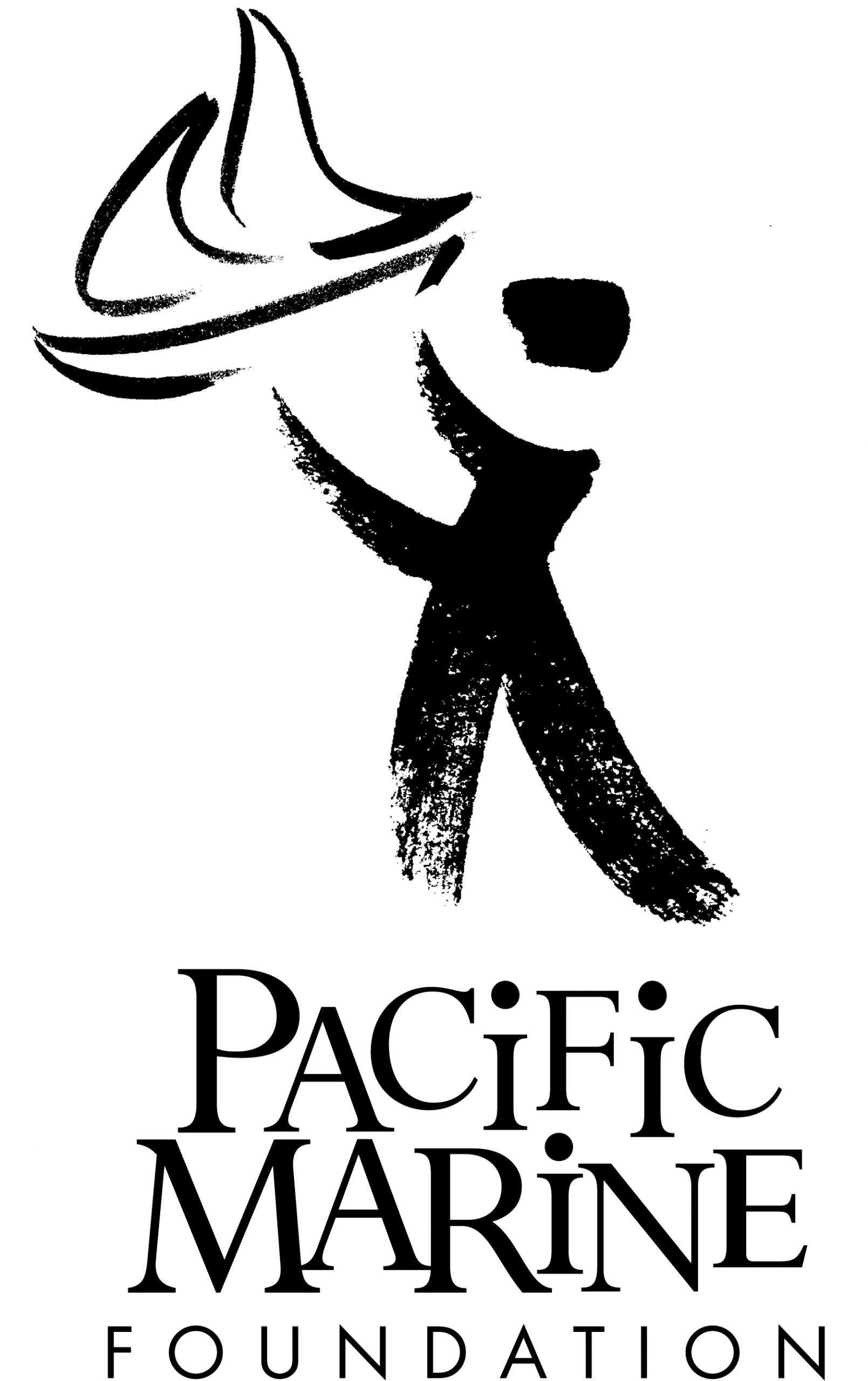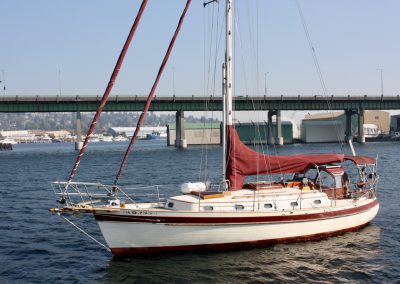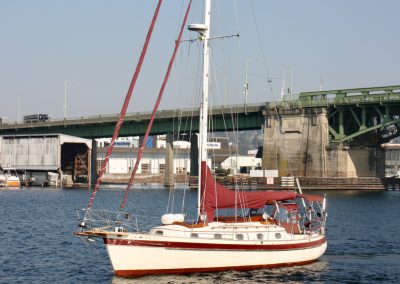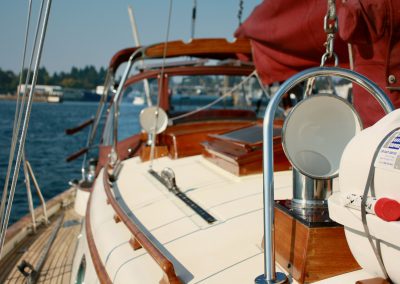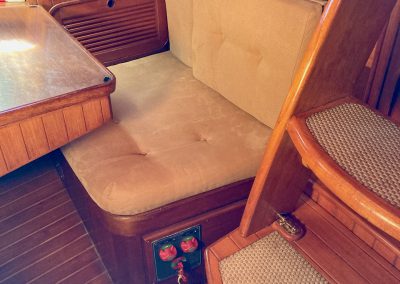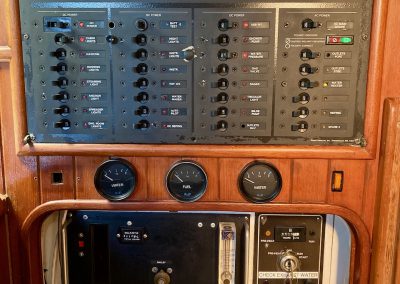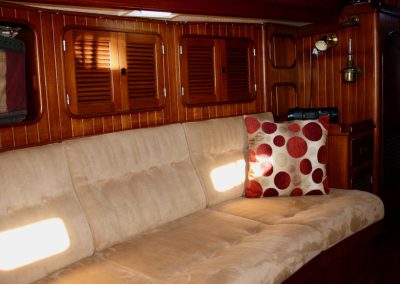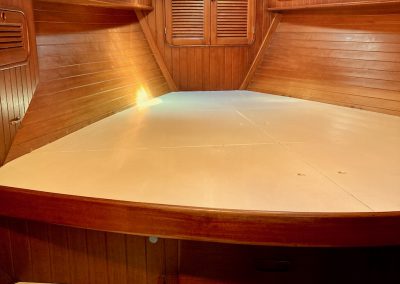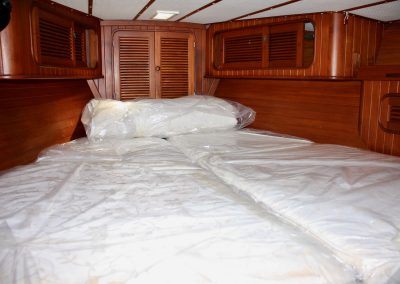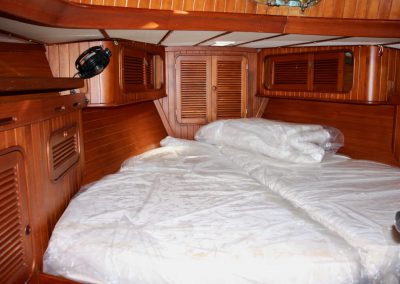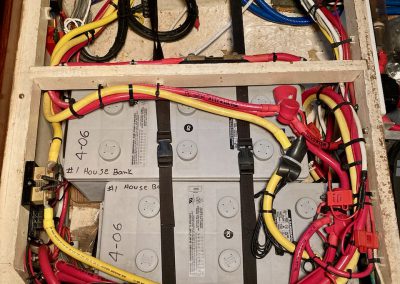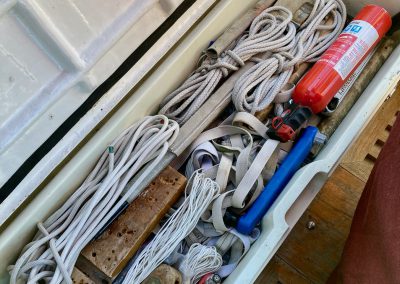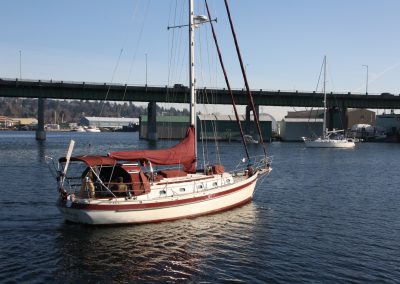One of just twenty-nine ‘Panda’ hulls completed in the famed Ta Shing yard, the inventory onboard “Restless” is very extensive and complete for your offshore sailing adventures to come. The boat has been exceptionally well maintained over the years, and now she’s fully ready to go ‘round again.
We installed a brand new Beta 38 diesel this past August and she’s performing just as expected, with good economical cruising speed of 6.5 kts. while under power during our recent trip from Anacortes to Seattle.
Her brightwork has been refinished in the warm weather over the past two summers and we have thoroughly checked and operated her systems top to bottom.
Numerous small repairs have been completed to bring ‘Restless’ to her very best condition including new Lexan panels for the hard dodger windscreen. She’s been well cleaned including her myriad custom canvas covers. The comfortable foam Queen-sized mattress in the forward cabin was sent out for professional cleaning last week.
The hull was surveyed and zincs replaced while ‘Restless’ was hauled for engine installation in August. There were no structural concerns indicated and the bottom paint is in good shape. That report will be made available in the process of completing a sale, thus saving her new owners an additional haul out expense.
Please take some time to review all of the details listed within.
If you’ve got that dream – we’ve got that boat.
Call soon … David Wallace 206.225.3360
______________________________________________________________________________
Dimensions and Tankage:
LOA: 40’ 7”
LOD: 37’ 6”
LWL: 31’ 5”
Beam: 12’
Depth: 5’ 8”
Displacement: 19,000 lbs.
Ballast: 6,600 lbs.
Cabin Headroom: 6’ 4”
Fuel: 140 gal., stainless steel (centerline)
Water: 75 gal., aluminum (port and stbd. settee)
Waste: 20 gal., fiberglass (molded centerline)
______________________________________________________________________________
Photo Gallery: click to enlarge and scroll through the photo set
______________________________________________________________________________
Specifications and Details
Electronics
Garmin GPSmap 3010C with Data cards:
1. Seattle
2. Northwest Coast of US and Alaska
3. CAN., US., West Coast
4. California to Mexico
5. South Pacific
6. Australia and New Zealand
7. Timor and New Guinea
8. Indonesia
9. Hong Kong and S. China Sea
10. Taiwan
11. Miscellaneous local data cards
Blue Chart – CD Rom: ‘America’ and ‘Pacific v. 7’
Garmin GMR 20/40 radar
iCom M802 Single sideband radio
iCom M504 VHF radio
BGH-1000 Navigation instruments in cockpit; wind, speed, direction
Vesper Marine AIS “Watch Mate” 850
One 12v plug at Nav table, one in the cockpit, two in the salon
Pactor (SCS Comp) modem connections at chart table
Plug-in for mobile GPS handheld reader
Mechanical
NEW ‘Beta-38’ four cylinder marine diesel, Hi-output 70 amp. alternator, Hurth V-drive, September, 2022.
Just 15 hours on new main engine; for mechanical sea trial and a run of 80 miles on delivery to Seattle
Beta “B” series instrument panel; tach. and temp. gauge, oil alarms, pre-heat, stop button and LCD display.
Main engine and Aux. diesel 4-D start battery
3 – 4D Gel House and Inverter Batteries under the quarter berth and Nav. table
Auxilliary Diesel Kubota 2-400B, 8.5 hp/3600 continuous DC output, 5,015 hours
New Facet lift assist pump for Kubota aux. engine, October, 2022
BalMar Hi-output alternator for the KubotaRefrigeration pump runs off the Kubota
Watermaker pump runs off the Kubota (575 hours on the pump)
Dual racor 75/500 water separators
Electrical
30 amp shore power cord
Spare shore power pigtails 20-30 amp in stowage bag
2 – Deka ‘Dominator’ Gel 4-D house batteries
1 – Interstate Group 27 Beta 38 start battery, new October, 2022
1 – Group 27 Kubota start battery
Battery switching and combining panel at nav. table
BEP Marine Matrix battery monitor
BalMar ARS battery regulator (spare)
Magnum Energy ME Series battery charger
2,000w output Magnum power inverter
Magnum Energy interface panel at navigation table
2 – Kyocera KC65T photovoltaic panels, output 65 watt max. x 2
Sails and Rigging
Selden aluminum mast, tall rig; 48’
All standing rigging replaced in 2005
Selden Furlex 300-S Genoa furling
Intermediate jib furling, with a spare ’emergency’ furler drum
Spinnaker pole on mast fitting
Mainsail; C. Hasse, Pt. Townsend
110% Genoa foresail; C. Hasse, Pt. Townsend
Intermediate staysail; C. Hasse, Pt. Townsend
Storn Tri-sail; C. Hasse, Pt. Townsend
Storm staysail; C. Hasse, Pt. Townsend
140% Asymmetrical spinnaker and chute: C. Hasse, Pt. Townsend
Spare mainsail (Neil Pryde, older)
All sails in bags, good condition
Galley
Force 10 two-burner propane stovetop and oven, butcher block top cover
Icebox with Technautic refrigeration plate system
Village Marine Tec 450 – Single membrane watermaker system powered by Kubota auxiliary pump
Seaward hot water tank; new element, pressure valve and thermostat, October, 2022
Dual stanless sink with new sprayer wand head
Two galley foot pumps; fresh water tank and watermaker test sample
Seven storage cabinets
Five storage drawers
Accommodations
Forward Cabin:
Queen berth, custom foam mattress and topper, 6’ 6” length, 6’ 3” wide at head
Mattress professionally cleaned, November, 2022
Large deck hatch, shaded plexiglass with screen
Five storage lockers
Cedar-lined hanging locker
Two 110v outlets
Two 12v. halogen reading lights in fwd. stateroom area
Aft quarter berth – 6’ 6” length, house batt. stowage and spares beneath, NO mattress pad.
Salon
Espar diesel heater (with spare filters, seals and hose)
Pioneer DVH-P5000MP – AM/FM/CD stereo
KLH bookshelf speakers in salon and forward stateroom
Phillips 17” LCD – HD monitor w/remote
Salon dining table has a fitted pad with vinyl cover
Salon butterfly hatch with screen
Port settee slides out to 6’ single berth
Intertec 110v oil radiator heater
True North 110v space heater
Two Caframo 110v fans
Caframo 12v clip-on fan
Four Kona 12v clip-on circulating fans
Four storage cabinets
Two bookcases
Four storage drawers
Hanging locker
Overhead red/white 12v lighting
Four 12v LED reading lamps
Two oil lamps
Ship’s bell
Riccar portable vacuum with hose and attahcments
Head and Shower
Flo-jet freshwater pump w/inline filter
Raritan manual toilet
Adjustable height shower wand fixture with new sprayer head
Shower sump discharges via 12v. pump to overboard
Marble countertop
Freshwater foot pump
Mirrored medicine cabinet
Full length mirror
12v circulating fan
Four cabinets
Two drawers
Two 12v LED lights
Overhead 12v red/white light
Deck and Gear
Emergency tiller
Fore and aft 20’ black mooring lines
Four inflatable Poly-foam fenders with clean black nylon covers
Teak bow pulpit with dual anchor rollers, cleaned and sealed
R/G running lights rewired through bow pulpit rail
Teak decking cleaned, sealed, new Sika caulking as needed
Teak decking routed, caulked, refastened and sealed 2008
Custom made maroon canvas covers for all of the brightwork
All canvas covers recently cleaned, in very good shape
Selden mast with Spartite deck seal and mast steps
Boom cover professionally cleaned, in very good shape
Aft cockpit bimini recently cleaned and in very good shape
Chromed Dorade vents newly powder coated inside for lasting appearance
Edson steering pedestal with canvas cover, recently cleaned
4” Ritchie helm compass
Folding mahogany table refinished and attached at helm pedestal
Folding seat cushions with backs and two ‘toss cushions’
Sailomat 601 self steering vane with multiple spare air vanes
Hard dodger with two solar panels and snapped storage bags within
NEW Lexan ‘polycarbonate 60’ inserts for the cockpit dodger, August, 2022
Simpson-Lawrence ‘SeaTiger 555’ manual dual capstan mechanical windlass
CQR Plow, 60 lb with 300’ all chain rode on bow pulpit roller
CQR Plow, 45 lb with 100’ chain and 300’ line in forepeak stowage
Fortress Danforth-style 12 lb. aluminum ‘lunch hook’ anchor on aft pulpit
300’ of 1″ braided line rode for spare anchor
150’ of spare 1” braided line in cockpit locker stowage
Anchoring bridle for foredeck mooring
Givens six-man canister inflatable liferaft in foredeck cradle
ACR Electronics EPIRB
Two 20lb aluminum propane tanks, regulator, gauge and solenoid shut-off in galley
Propane line and fitting for adding a barbecue on the aft rail
Novalift MOB hoisting davit at stern rail
Lifesling on aft rail with custom maroon canvas cover to match
Windlass handle, winch handles, fire extinguisher in cockpit locker
Small line, tie downs, miscellaneous small hardware in cockpit locker
Whale Gusher manual bilge pump in cockpit
Teak 8’ boat pole
Exterior cleaning supplies
An extensive and exceptionally well constructed inventory of custom made maroon canvas covers and fittings for all brightwork, helm pedestal, winches, sail bags, ditty bags, etc. Black mesh screened enclosures for the cockpit. All in good, serviceable condition, and some nearly new.
Miscellaneous and Spares
Operations manuals for everything, organized and stowed aboard
Beta Diesel engine operation and repair manuals
Kubota auxiliary diesel repair guide
Spare starter for Kubota, raw water impeller, belts, and fuel and oil filters
Spare motor mounts for Kubota
Spare BalMar rebuilt two-pulley alternator
Filters, gaskets, etc. as spare for Espar heater
Spare Sanden 505 refrigeration compressor pump
Fuses, connectors, wiring spares
Jabsco oil change hand pump
Water purifying solution, lamp oils
Racor separator filters and freshwater filters
Storage tote #1 – black rubbermaid; hardware, terminals and blocks for running rigging, stowed in salon hanging locker
Storage tote #2 – Rigging hardware, furler fittings, spare drum, freshwater pump, misc. hardware [beneath vee berth]
Storage tote #3 – Epoxy, fillers, lube sprays, degreasers, purifier solution for watermaker,. lubricants [beneath vee berth]
Storage tote #4 – Enamels paints, varnish, brushes, rollers, solvents, misc. supplies [beneath vee berth]
Storage tote #5 – Assorted sizes of teak and mahogany bungs, sanding discs and pads, sealer [beneath vee berth]
Storage tote #6 – fuel and oil filters for genset, new spare starter motor, Sanden refrigeration pump
Qtr. berth storage – Water, fuel and misc. hose segments, stays and shrouds 3/8” and 1/4”
Engine Compartment storage – Oil, filters, coolant, ATF, various cleaning supplies
Vee berth storage – large Rubbermaid tote for spare canvas, mesh duffle bag with fitted mesh cockpit enclosure pieces, engine belts for Kubota auxilliary engine.
______________________________________________________________________________
Additional Custom Canvas (not shown in photos)
Boom crutch cover
Cover for Lifesling rail mounted overboard toss ring’
Maroon canvas and black mesh cockpit curtains
Foresail deck stowage bag for forestay
Three canvas stowage bags for loose canvas and miscellaneous
Windlass cover
Bimini cover, for use when the frame is folded up
Sail stowage bags, labeled, by Hasse
Mast partners trim ring
Spare sail cloth, canvas, black mesh, rubber shelf liner, ‘diamond’ cockpit coaming nonskid
All custom canvas was meticulously designed and fabricated by former owners!
______________________________________________________________________________
~ ~ Information about “Restless” from her Former Owners ~ ~
The following article was authored by “Restless” former owner Mary Brandon Fox, March 4, 2010, as it appeared in Cruising World Magazine, and is reprinted here with her permission. Reprinted from “Classic Plastic”, in the February, 2010 issue.
Panda 38′
“Teak and bronze finery belie the Panda 38’s solid cruising capabilities.”
The Panda 38 is built like a piece of fine furniture, and the boat’s sea-kindly motion will take care of you in a blow offshore.
The respected Ta Shing Yard in Taiwan built the Panda 38 in the 1980s for Bob Berg and the Quicksilver Corporation. It was designed to be a lighter, faster, and smaller sibling to the Panda 40 while retaining the solid offshore capability for which Berg’s boats were known.
Designer Gary Grant gave the Panda 38 traditional lines that are accentuated by generous applications of teak used on the wide caprail, bronze-capped rubrail, grabrails, and cockpit coaming. Most of the boats were cutter rigged as a factory option and were fitted with a generous bowsprit. A vented teak platform attached to the bowsprit accommodates dual bronze anchor rollers.
Ta Shing’s interior teak joinery and craftsmanship is legendary. Aboard our Panda 38, Restless, we feel as though we live in a fine piece of furniture. The bulkheads are vertical teak staving; the overhead, between the laminated beams, is made of removable panels of laminate or spruce staving; locker doors are louvered teak. A teak grate at the foot of the companionway drains through a pan into the bilge.
The roomy and seaworthy U-shaped galley is to port of the companionway. On the starboard side, the forward-facing navigation station has adequate room for instrumentation and ample space in which to work. In some boats, the layout of galley and nav station was reversed.
The main saloon provides a generous area for living and entertaining, with a settee/sea berth to port and, to starboard, a U-shaped dinette that seats four comfortably. The master stateroom, in the bow, has a king-size V-berth. Aft of it, on the starboard side, the head has a marble countertop and a separate shower. Aft of the navigation station is a quarter berth.
Twelve old-school bronze opening ports, four cowl vents on teak dorade boxes, a forward-opening teak hatch in the V-berth, and an elegant teak butterfly hatch over the main cabin provide excellent airflow throughout the interior
While the standard engine was the Universal 40-hp. diesel, some boats, including ours, have a Universal 50. The V-drive transmission leaks notoriously and has been replaced on many boats. Access to the engine area under the cockpit is outstanding.
Generous tankage permits extended cruising: A black-iron tank under the saloon sole carries 75 gallons of diesel, and two stainless-steel tanks under the settees hold 140 gallons of water between them.
The Panda 38’s teak decks are laid on top of a fiberglass sandwich. When we removed hardware to recaulk the deck, we found that the deck core is made of individual 2-inch balsa squares with resin barriers between them, which limits core damage when a leak occurs.
A moderate performer under sail, the P38 goes to weather pretty well even in light air. The boat will turn in 150 miles in 24 hours with 10 knots or more forward of the beam, but if it’s aft of the beam, the Panda needs more wind to perform in any significant sea state. The more wind, the more the 38 likes it. The boat has a sea-kindly motion and modest weather helm. The bathtub cockpit is rather small. We feel tucked in and safe when passage-making, but it seats only four to six people comfortably at anchor.
Our Panda 38 has proven to be a strong and solid sailboat and a comfortable home. Ta Shing built 29 of them during the early 1980s. They’re rare; expect asking prices between $100,000 and $125,000, depending on equipment and whether the abundant teak is in a gray “natural state” or in show condition.
For more information, visit the Baba-Panda-Tashiba owners website (www.groups.yahoo.com/group/baba-l).
Mary Brandon “Brandy” Fox and her husband, Mark, sailed their Panda 38, “Restless”, from Seattle to Patagonia via California, Mexico, Ecuador, Easter Island, and Chile.
_______________________________________________________________________________
~ ~ Historical and Performance Notes; Authored by the Staff of BluewaterBoats.org ~ ~
[ Original Publication: https://sailboat.guide/ta-shing/panda-38 ]
The Panda 38 is a 40′ 7″ monohull sailboat designed by Gary Grant and built by Ta Shing Yacht Building Ltd. starting in 1982.
The Panda 38, introduced in 1982, comes from a whole family of Scandinavian styled cruisers developed by Bob Berg in the mid-1970s through to the mid-1980s which included the popular Baba 30, 35 and 40 designs from Bob Perry. The boat was originally conceived as a smaller and lighter alternative to the Panda 40 (aka Baba 40). Like other boats from Berg, the Panda 38 was built by Ta Shing which has been generally considered the best boatyard in Taiwan, and the stunning interiors reflect this.
The Panda 38 has a reputation for sea-kindly motion, easy handling, and brisk performance. Since its introduction, only 29 have been built so they are quite rare to find on the market, and like all boats from the Bob Berg / Ta Shing duo, they have enjoyed an avid fan base.
History
Delving into the history of the Panda 38 we need to step back to 1976, the year that brought the world the Baba 30. The little boat was the brainchild of Berg who knitted together the design talents of Bob Perry with his new discovery, a small boatyard called Shing Sheng. The Baba 30 reinforced to the American public the kind of boat that could be built in Taiwan. It was a salty full keeled cruiser that packed an incredibly livable interior into 30 feet. Brimming with quality, the boat helped the yard (now operating out of purpose-built facilities under the name Ta Shing) in the direction of becoming Taiwan’s premier boatyard.
The Baba 30 led to the 35, and culminated in the fast and luxurious full-keeled Baba 40, a boat that had its lines derived from the now legendary Valiant 40. After a naming rights kerfuffle the Baba 40 became the Panda 40. Roughly the same time, in 1981, Bob Berg was looking for a smaller and lighter alternative. As Berg puts it:
“… the market demanded a smaller and lighter weight boat with a different stern than the Baba 40. I envisioned a stern similar to the ‘James W. Hart’, a catboat that Bill Garden designed with an old-time extended counter stern. This type of stern allowed for a larger cockpit.”
For the design he commissioned Gary Grant who had prior experience with this style of boat having worked in the Perry design office. It was to be his first commission as an independent designer. He set about tweaking the design formula to maximize waterline length, reducing wetted surface area and reducing displacement.
The boat was of course built by Ta Shing and was introduced in the latter part of 1982. Though most of the records were shredded in 1992, Berg says the records indicate at least 29 boats were built. Most were sold into the Pacific North West. Interestingly, the first Panda 38 off the production line was White Bear, Berg’s own boat, the name being the literal Chinese translation of Panda Bear.
Configuration & Layout
The Panda 38 is a Scandinavian style cruiser like Berg’s previous boats, there’s a cutter rig (though many owners like to sail their boat as sloops with a removable inner stay), a three foot bowsprit, and a flat bottomed full keel. And like the prior boats that were designed by Perry (Baba 30, 35, 40) , Grant follows the same formula by cutting away the keel’s forefoot and firming up the turn of the bilge to reduce drag. The hull’s canoe underbody remains flat well aft to improve downwind performance. To make the boat easy to short hand, Grant reduced the sail area which led to a significant reduction in displacement. The Panda 38 weighs in at a full 10,000 lbs less than the Panda 40.
Visually, perhaps the most striking difference from prior boats has been the departure from the canoe stern in favor of a transom. Berg says “I decided to come out with a boat with a different stern design because I felt that not every sailor wanted a double-ender“. Regardless, the transom usefully increases the usable deck space and aids the waterline length slightly.
The bathtub-like cockpit is suitably small for bluewater passage-making, but seats only four to six people comfortably at anchor.
Below deck, some of the true quality of the boat comes to light. The sheer quantity and quality of the teak joinery work is striking and utilization of space is impeccable. Berg was well known to work over every fine detail at the Ta Shing factory, looking for clever ways to use every nook and cranny.
There’s a huge well designed galley with generous dry storage areas.
The boats came with the option of the galley port or starboard. With the port located galley, to starboard was placed the navigation station with the navigator’s seat formed by part of the seagoing quarter berth which runs further aft. In the starboard located galley, to port was placed a generous wet-locker space with a reverse facing navigation station further forward utilizing the port settee as a seat.
The sole below the companionway is sensibly made from teak grating to allow drainage while changing out of wet weather gear. Access to the engine behind the companionway stairs is excellent.
In the main salon are settee berths port and starboard, there’s plenty of space for living and entertaining around a U-shaped dinette seating four in comfort. Above is an elegant teak butterfly hatch offering good ventilation. Further forward to starboard is the head with separate shower. At the very front, most boats have a stateroom consisting of a queen sized berth though a few boats were optionally fitted with V-berths.
Construction
The Panda 38’s hull is constructed in hand laid fiberglass, while the decks share similar treatment with a coring of end grain balsa broken into two inch squares with resin barriers to limit potential for rot damage from leaks. Ballast consists of 6,600 pounds of iron cast in a single piece and sealed and glassed over.
The bulkheads consist of vertical teak staving, while overhead, between the laminated beams are removable sheet laminate or spruce staving. In efforts to reduce condensation, the hull’s interior is lined with polyurethane foam in the living areas.
Under Sail
The Panda 38 is a good performer under sail, she is sea-kindly and is known to excel to weather regardless of light air. In fact owners report 150 mile days with only ten knots of wind in a close reach, more wind is required when downwind in any significant sea state. We hear the overall boat speed of the Panda 38 is close to that of the impressive Baba 40.
In terms of balance, the boat exhibits a slight weather helm with a particularly good rudder response (aiding close quarter maneuvering).
Links, References and Further Reading
» Baba, Panda, Tashiba sailboat Yahoo Group, information and owner discussions.
» Sea Magazine, Mar 1984 (p52-p55), Panda 38 Sea Trial by Bob Vollmer
» Cruising World Magazine, Mar 2004, Panda 38: Passagemaking Princess by Mary Brandon Fox
Credits
For their assistance in the research of this article, thanks goes out to Bob Berg, Tim Ellis (who managed boat production at Ta Shing) as well as owners from the Baba, Panda, Tashiba group, particularly Michael McConnell, Bruce Pappas, and Hal & Patsy Cook.
_______________________________________________________________________________
~ ~ About Our Pacific Marine Foundation ~ ~
We are selective about the vessels we accept into our program and we pursue a very rigorous process before they are listed for sale. This begins when we first meet with our donors to discuss the condition and recent upkeep of their boat. Once accepted, each new arrival undergoes a thorough examination, similar to what a marine surveyor will do. This allows us to prioritize our attention to any deferred maintenance or repairs that may be needed.
Over the years we have performed just about every kind of marine repair, from electrical and plumbing issues to all types of appearance enhancements and even rebuilding engines. If something is not working right we fix it, simple as that. We prove that her electrical, mechanical and plumbing systems are correct, safe and functioning properly. By doing all of this we know our boats quite well from top to bottom and present them fairly and honestly to buyers.
We encourage you to have our boats professionally surveyed as a part of your purchase process. By the time we’ve finished and the boat is advertised, we’re confident you will receive a strong report from your surveyor.
Thank you for considering PMF boats in your search !
